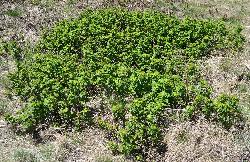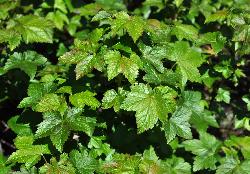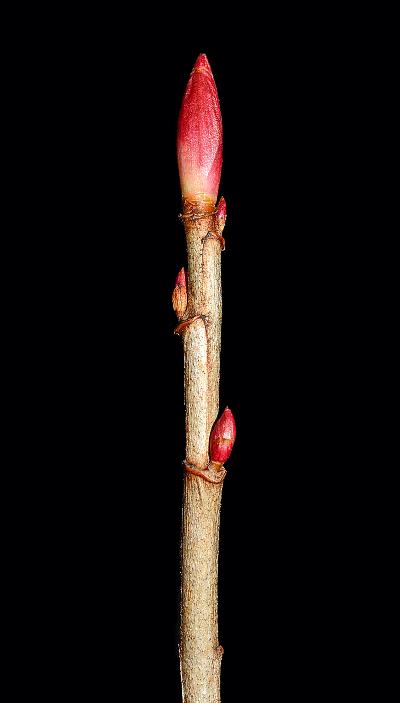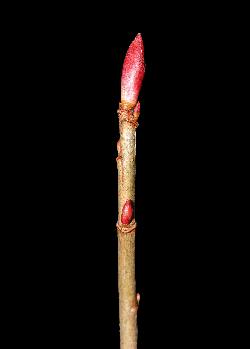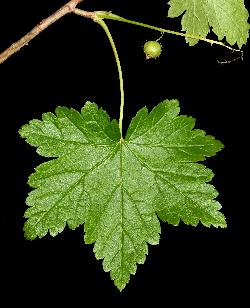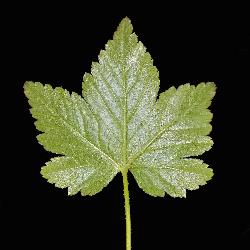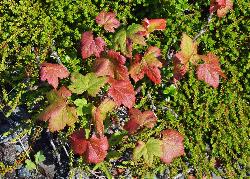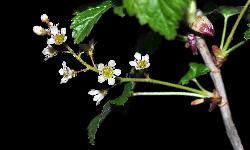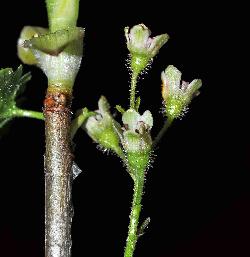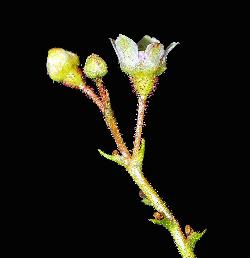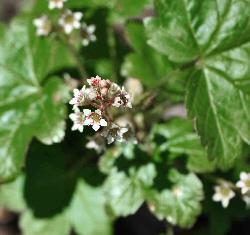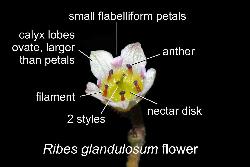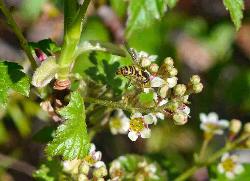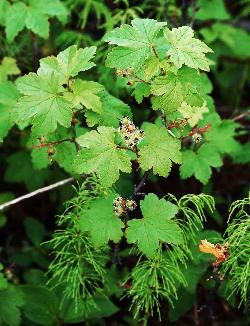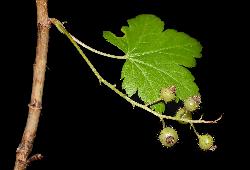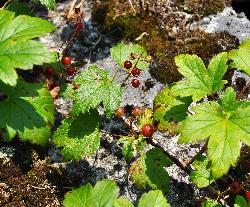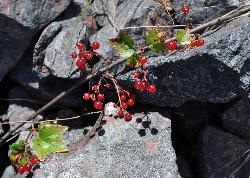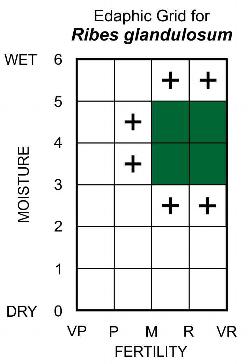Fr: gadellier glanduleux, gadellier malodorant, gadellier couché
IA: minitshiminakashi, minitshimin, innishkuai, innitshimin
IU: kimminaujak, mikKulik, ummilikkuluk, ummilikuluk
Grossulariaceae - Currant Family
Note: Numbers provided in square brackets in the text refer to the image presented above; image numbers are displayed to the lower left of each image.
General: An erect to straggling or prostrate deciduous shrub, 0.5–1 m tall, rhizomatous, often forming large clones [1–2], and producing bristly red berries [3]. Skunk current is easily identifiable in the field due to the skunky odour of crushed leaves, stems, and fruit. Skunk currant berries are edible when ripe and may be made into jams; they are also eaten by a variety of birds and small mammals. All currant species, including skunk currant, are alternate hosts for white pine blister rust (Cronartium ribicola F.C. Fisch.), a serious disease of Pinus strobus and other 5-needles pine species.
Key Features: (numbers 1–3 refer to the illustration [4])
1. Stems are unarmed; stems and leaves have a skunky odour when crushed; leaf blades are palmately 5–7 lobed and divided to about the middle of the blade.
2. Flowers are white to pinkish and arranged in erect racemes.
3. Berries are dark red, glandular-bristly, and borne in spreading racemes.
Stems/twigs: The stems of new growth bear fine glandular hairs, but woody twigs are glabrous, greenish-brown to reddish-brown, unarmed, and have decurrent lines extending down from both ends of leaf scars. Buds are lanceoloid, sharply pointed, and have 6 or more imbricate bud scales [5–6]. Leaf scars are narrow, broadly V-shaped, and have 3 bundle trace scars [6].
Leaves: Alternate, simple, palmately lobed, and petiolate; petioles are 3–5.5 cm long, somewhat clasping at the base, finely short-pubescent, and bear stipitate glandular hairs; a few long hairs occur near the somewhat expanded base of the petiole. Leaf blades are 2–8 cm long by 4–8 cm wide, and divided into 5–7 ovate-triangular lobes [7–9]. The central and upper pair of lobes are about equal in size, while lower pairs of lobes are progressively smaller near the base; sinuses between the lobes are very narrow. Leaf bases are cordate, apices are acute, and margins are coarsely serrate to biserrate, with rounded blunt-tipped to acute teeth. The blade is bright to dark green above, glabrous, and often somewhat lustrous; the lower surface is only slightly paler [10] and finely pubescent along the veins; leaves turn red in the autumn [11].
Flowers: Bisexual, in ascending to erect racemes, 2.5–6 cm long, of 6–15 flowers [12–14], and emerging from lateral buds on woody stems; the axis of the inflorescence, pedicels, and outer surface of the shallow saucer-shaped hypanthium are densely covered in stipitate-glandular hairs [15–16]; pedicels are 2–7 mm long and jointed. Each flower is subtended by a narrow lanceolate bract, 1–2 cm long [16]. Flowers have a petaloid calyx with 5 oblong to obovate, greenish-white to pinkish lobes, borne at the rim of the hypanthium; the 5 smaller petals are fan-shaped (flabelliform) to obovate, usually pink, and alternate with the calyx lobes [17–18]. The inner surface of the hypanthium is covered by a yellow nectar disk; situated at the edge of the disk, opposite the calyx lobes are 5 stamens, with red filaments and red to dark purple anthers [18–19]; the ovary is inferior and has 2 styles connate at the base. Flowers bloom in early summer. All native Ribes species in our area can self-fertilize, but they are also pollinated primarily by bumblebees (Bombus spp.) and honeybees (Apis spp.), as well as other bees and flies (entomophily) (Bratsch and Williams 2009). Syrphid flies (Syrphinae) have also been observed nectaring on skunk currant flowers [20].
Fruit: Clusters of globose berries, each 6–8 mm in diameter; technically, the fruit is a false berry, since the ovary is inferior and adnate to the hypanthium tube; true berries are derived from superior ovaries, with only the ovary developing into a fleshy berry. Berries are initially light green and opaque [21–22], maturing to a translucent deep red; the surface is covered with gland-tipped bristles on the surface [23–24]. The small shrivelled perianth is persistent on the developing fruit. The berries are edible, but have a somewhat unpleasant taste until they ripen in mid-summer. Dispersal is by a variety of small mammals and birds, who eat the fruit (endozoochory).
Ecology and Habitat: Skunk currant usually occurs in small patches in moist to wet nutrient-rich forests. It can also be found on riverbanks, at the edges of wetlands, on talus slopes, and above treeline. Skunk current is an indicator plant used to differentiate moist to wet nutrient-rich forests.
Edaphic Grid: See image [25]: the Edaphic Grid for Ribes glandulosum.
Forest Types: Skunk currant occurs in the following forest types:
Abietum rubetosum (Rubus-Balsam Fir Subassociation)
Abietum dryopteretosum (Dryopteris-Balsam Fir Subassociation)
Abietum taxetosum (Taxus-Balsam Fir Subassociation)
Betuletum dryopteretosum (Dryopteris-White Birch Subassociation)
Aceretum spicatae (Mountain Maple Thicket Association)
Alnetum typicum (Moist Alder Swamp Subassociation)
Alnetum solidagetosum (Solidago-Alder Swamp Subassociation)
Skunk current was also recorded for the Birch Forest and Fir-Spruce-Feathermoss Forest vegetation types in southeastern Labrador (Foster and King 1986). Alnetum caricetosum (Carex-Alder Swamp Subassociation)
Succession: Skunk current appears to be able to survive in partially shaded habitats. It can be observed as an early successional species on burns and cutovers, but does not appear to spread rapidly in response to release from shade.
Distribution: Ribes glandulosum is a north-temperate to boreal species that occurs throughout insular Newfoundland and can be found in Labrador as far north as about 58° N (Scoggan 1978). Its range in North America extends from Newfoundland and Labrador west to Alaska, and includes all Canadian Provinces. In the United States, it occurs from Maine west to Minnesota and southwest to Tennessee (Morin 2009).
Similar Species: Currants and gooseberries are both classified as species of the same genus (Ribes), but currants have several flowers arranged in long racemes, their flowers are borne on jointed pedicels, and the hypanthium is open and saucer-shaped; gooseberries have 1–3 flowers borne on unjointed pedicels in leaf axils, and their flowers have a short tubular hypanthium. The swamp red currant (Ribes triste Pall.) is the only other native current in our province that has red berries, but the surface is glabrous, and racemes occur in drooping clusters. The leaves of swamp red currant have divergent to broadly cordate bases, broad triangular lobes, and biserrate margins.


